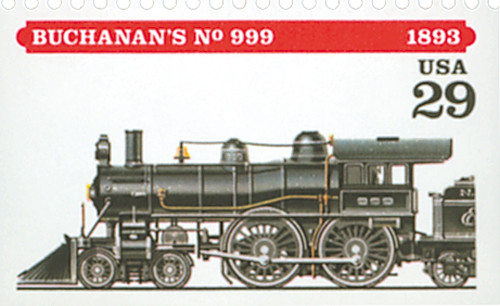
# 2847 FDC - 1994 29c Locomotives: Buchanan's #999
US #2847
1994 Buchanan’s No. 999
- First Day Cover
- Stamp is part of set of five picturing American locomotives
- Similar in design to 1987 Locomotive stamps
Category of Stamp: Commemorative
Set: Locomotives
Value: 29¢, First-Class Mail rate
First Day of Issue: July 28, 1994
First Day City: Chama, New Mexico
Printed by: Stamp Venturers
Printing Method/Format: Photogravure. Four panes of five stamps, from printing cylinders of 200 (10 across, 20 down)
Perforations: 11
Reason the stamp was issued: Locomotives are a popular topic with stamp collectors. These stamps appealed to them, as well as train enthusiasts.
About the stamp design: The five stamps picture locomotives produced in America in the last half of the 19th century. Each locomotive was built in a different decade. Richard Leech, who had designed the first set of Locomotive stamps (US 2363-66), worked with his son Kent on the illustrations for these stamps. Richard sketched each locomotive facing left. Kent outlined the work in pen, then Richard finished the artwork with watercolor and airbrush.
First Day City: The Locomotive stamps were dedicated in Chama, New Mexico, the site of the Cumbres and Toltec Scenic Railroad. This route runs from Cumbres Pass to Antonito, Colorado.
About the Set: This stamp is part of a set of five picturing historic locomotives built between 1850 and 1900. Each stamp shows a locomotive constructed during a different decade. Those depicted in this set are: Hudson’s General, McQueen’s Jupiter, Eddy’s No. 242, Ely’s No. 10, and Buchanan’s No. 999.
History the stamp represents:
Built in 1893 for the New York Central & Hudson River Railroad, William Buchanan’s No. 999 was the first engine in the world to exceed 100 miles per hour. Hauling the Empire State Express at 112 mph from Batavia, New York to Buffalo, the No. 999 set not only a world record for steam locomotives, but for any kind of transportation at that time.
During the 1893 Columbian Exposition, the Empire State Express ran between New York and Chicago, completing the 960-mile journey in just under 20 hours - an unprecedented time for any journey of similar length. Of the 62 locomotives shown at the exposition, the No. 999 was by far the most popular. The combination of speed and luxury resulted in one of the most famous trains in the world, and after the exposition it continued to run year-round, making daily trips from Chicago to New York.
So popular was the Empire State Express, it even appeared on the 1901 2¢ Pan-American stamp, though the locomotive pulling the train was not No. 999 but another Buchanan locomotive, No 938. Wanting to show the superiority of American technology, postal officials decided this well-known train was the ideal subject for the 2¢ stamp that featured a “Fast Express.” Today the No. 999 stands on display at the Chicago Museum of Science and Industry.
US #2847
1994 Buchanan’s No. 999
- First Day Cover
- Stamp is part of set of five picturing American locomotives
- Similar in design to 1987 Locomotive stamps
Category of Stamp: Commemorative
Set: Locomotives
Value: 29¢, First-Class Mail rate
First Day of Issue: July 28, 1994
First Day City: Chama, New Mexico
Printed by: Stamp Venturers
Printing Method/Format: Photogravure. Four panes of five stamps, from printing cylinders of 200 (10 across, 20 down)
Perforations: 11
Reason the stamp was issued: Locomotives are a popular topic with stamp collectors. These stamps appealed to them, as well as train enthusiasts.
About the stamp design: The five stamps picture locomotives produced in America in the last half of the 19th century. Each locomotive was built in a different decade. Richard Leech, who had designed the first set of Locomotive stamps (US 2363-66), worked with his son Kent on the illustrations for these stamps. Richard sketched each locomotive facing left. Kent outlined the work in pen, then Richard finished the artwork with watercolor and airbrush.
First Day City: The Locomotive stamps were dedicated in Chama, New Mexico, the site of the Cumbres and Toltec Scenic Railroad. This route runs from Cumbres Pass to Antonito, Colorado.
About the Set: This stamp is part of a set of five picturing historic locomotives built between 1850 and 1900. Each stamp shows a locomotive constructed during a different decade. Those depicted in this set are: Hudson’s General, McQueen’s Jupiter, Eddy’s No. 242, Ely’s No. 10, and Buchanan’s No. 999.
History the stamp represents:
Built in 1893 for the New York Central & Hudson River Railroad, William Buchanan’s No. 999 was the first engine in the world to exceed 100 miles per hour. Hauling the Empire State Express at 112 mph from Batavia, New York to Buffalo, the No. 999 set not only a world record for steam locomotives, but for any kind of transportation at that time.
During the 1893 Columbian Exposition, the Empire State Express ran between New York and Chicago, completing the 960-mile journey in just under 20 hours - an unprecedented time for any journey of similar length. Of the 62 locomotives shown at the exposition, the No. 999 was by far the most popular. The combination of speed and luxury resulted in one of the most famous trains in the world, and after the exposition it continued to run year-round, making daily trips from Chicago to New York.
So popular was the Empire State Express, it even appeared on the 1901 2¢ Pan-American stamp, though the locomotive pulling the train was not No. 999 but another Buchanan locomotive, No 938. Wanting to show the superiority of American technology, postal officials decided this well-known train was the ideal subject for the 2¢ stamp that featured a “Fast Express.” Today the No. 999 stands on display at the Chicago Museum of Science and Industry.












